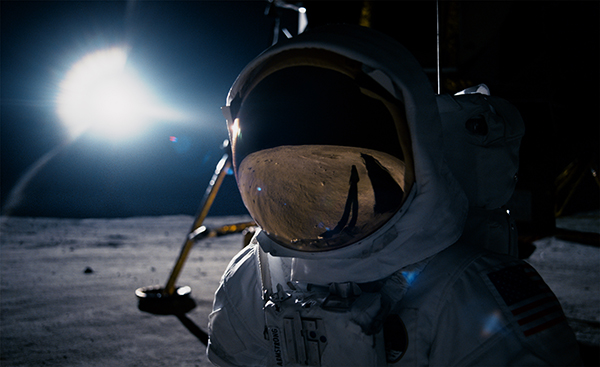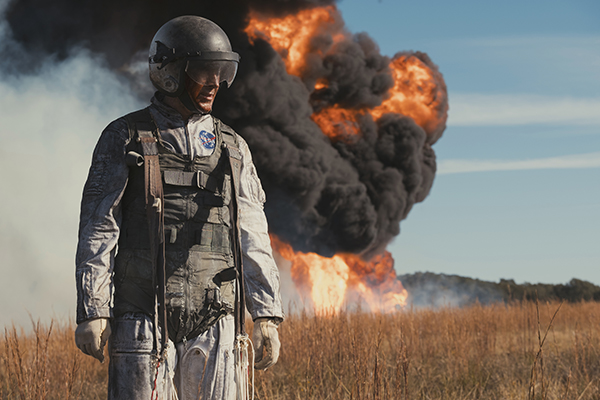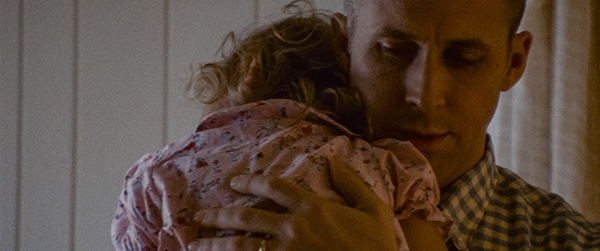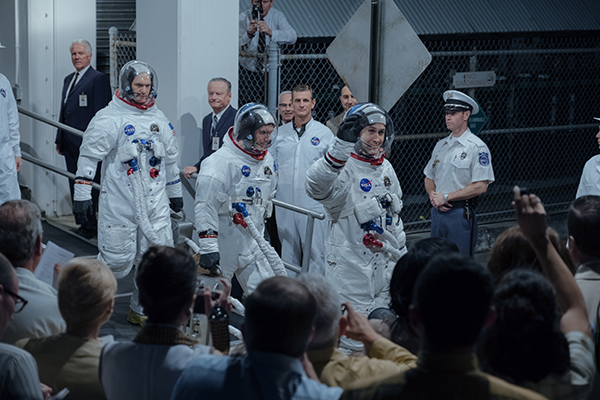
by Mark Carpenter Thursday, October 11, 2018

Warning: Spoilers ahead
“First Man” is a vivid depiction of Neil Armstrong’s life during NASA’s ambitious and terrifying program to reach the moon. The film uses exquisite cinematography to portray the crowning achievement of the space race — Armstrong becoming the first human to walk on the moon on July 20, 1969. Directed by Damien Chazelle, who won an Academy Award for his direction of “La La Land,” the film navigates a fine line among the triumphs and tragedies of the Gemini and Apollo missions, while also telling the story of the home lives of the astronauts and their families. The dynamics in this human drama cannot be solely explained by physics.
“First Man” accepts that viewers already know the outcome of Apollo 11, the mission that first landed humans on the moon. So the filmmakers instead focus on immersing viewers in each scene through sheer production brilliance.
Within seconds of the beginning of the film — especially if you see it in an IMAX theater — your blood will be rushing to your feet from the pull of 4 Gs as you ride along with Armstrong in his X-15 rocket plane, which shakes so hard that disintegration seems imminent. You’re at no risk of passing out, but please don’t puke — especially on Chazelle’s lovingly reconstructed cockpit control panel, in all its analog, lightly corroded, well-labeled, but not fully tested glory. The payoff is that you get to sit in silence with Armstrong at the edge of space. But unlike you, he’s calm.
Once in space, the closeup camera work will make you feel suitably claustrophobic. Then, with insufficient atmosphere for the X-15 to bite into, the plane drops into an endless vertigo-inducing spin. The feeling of dropping to Earth from an altitude of 42 kilometers is sure to raise your pulse. And Chazelle quashes any hope of watching the scene with any degree of detachment by denying the viewer a wide exterior shot. So, when ground control screams, “Neil, hard left turn!” you really hope he makes it.

"First Man" delivers an intense, immersive viewing experience, especially in IMAX. Credit: Universal Pictures
Likewise, the Apollo 11 sequence is an inspiring piece of filmmaking. As the Eagle lander passes low over the moon’s cratered surface, the stunning detail will not fail to give you goosebumps. In the distance we see the little blue marble painted against space. What must it have been like to be these men in that place? The film, based on James R. Hansen’s book “First Man: The Life of Neil A. Armstrong,” which contains rare personal interviews with the famously private astronaut, attempts to show us.
In the film, Armstrong is played by a well-cast Ryan Gosling: a subdued actor playing a man who rarely shares his inner thoughts. Gosling portrays Armstrong at home — with his wife Janet, played brilliantly by Claire Foy of “The Crown” — with sensitivity. It’s touching to hear Neil sing, holding his sick little girl Karen, “I see the moon, and the moon sees me, down through the leaves of the old oak tree …” We grieve with the family when Karen, just age 3, dies.

Ryan Gosling's restrained portrayal of Neil Armstrong in "First Man" accurately conveys the astronaut's stoicism and compassion in "First Man." Credit: Universal Pictures
Because of Armstrong’s stoical nature, for much of the film, viewers will be well aware of what is not being said outright. This is especially true in the depictions of how Neil and Janet cope with the loss of their daughter, and how the astronauts interact in dealing with, or rather not dealing with, the deaths of three of their colleagues in the Apollo 1 launchpad fire. As stoic as Armstrong might be, his wry, straight-faced sense of humor, sprinkled economically throughout the film, comes through clearly. Sometimes it’s as if he’s enjoying a private joke.

The set design, wardrobe and soundtrack are all so precise that viewers are effortlessly transported to 1960s suburban Houston, the safe, middle-class world where the families of the astronauts lived. It’s a world of poolside sun loungers and kids playing on lawns, plaid shirts, sleeveless dresses, flat shoes, bobbed hairdos and the modern conveniences of midcentury kitchens. But Chazelle cleverly widens the view to include the zeitgeist of the era — with protests of the Vietnam War, Kurt Vonnegut questioning the cost of the space program and poet Gil Scott-Heron lamenting poverty at home while “Whitey’s on the moon” — to show how that insular world is built on a foundation of tension and uncertainty.
The story, told chronologically, delights in history’s minutiae: for example, seeing Neil reading the job ad to join NASA is both surreal and ordinary. Overall, the storytelling works well, and viewers see how Armstrong’s intelligence, steel nerves and perseverance in the face of failure makes him a natural choice for the later missions. Equally impressive is Janet’s courage on the ground. After her home radio link is cut by NASA to save her from hearing her husband’s imminent blackout in Gemini 8, she storms over to Deke Slayton, NASA director of flight operations, and demands that he turn the box back on. Janet’s steadfast realism is the dynamo that drives the domestic plot, which sometimes doesn’t show Neil in the best light. Without her demanding that Neil tell their young sons that he was leaving for the moon, how little might he have said?
Claire Foy's dynamic portrayal of Janet Armstrong drives the domestic plot. Credit: Universal Pictures
However, at times, like Janet, viewers may be left wanting to know more. We learn very little about the lives of the other astronauts, for example. Also, little tribute is paid to the mountain of science, mathematics and technology that made possible the spaceflights of Armstrong and others. Certainly, viewers will see plenty of hardware in action — such as the G-force limiter that failed in the X-15, resulting in the tailspin — you just won’t learn much about it. For that, viewers will have to go elsewhere, like HBO’s “From the Earth to the Moon.”
Chazelle does not rush the film’s finale. Shot from the perspective of the ladder camera on the lunar lander, viewers see Armstrong descend into the soft dust of the lunar surface and take the most famous step in history. Beyond his visor lies the silence of space. For that moment, you can sit back and watch the first man on the moon, without needing to ask more questions of him.
None of us is going to the moon any time soon, including Elon Musk and Richard Branson. So, head to the movies. You might get a sore neck or wish for a little more insight from the dialogue, but you won’t be disappointed.
“First Man” opens in theaters across the U.S. today.
© 2008-2021. All rights reserved. Any copying, redistribution or retransmission of any of the contents of this service without the expressed written permission of the American Geosciences Institute is expressly prohibited. Click here for all copyright requests.